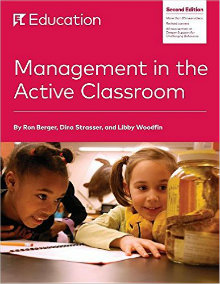Managing Learning in the Active Classroom
Management in the Active Classroom (2nd Edition)
By Ron Berger, Dina Strasser, and Libby Woodfin
(EL Education, 2015 – Learn more)

When one of Jodi’s new students asked her “When do we get to build and play?” she realized that this group was not going to be the type of learners who would be successful sitting and getting.
Providing choice and physical activity during the school day became Jodi’s focus for the school year. This provided lots of opportunities for student autonomy and movement, something all learners need in order to become engaged in their work. Yet, this also called for a unique approach to classroom management.

- A sense of competence (I can succeed here)
- A sense of community (I belong here)
- A sense of choice (I am trusted to make wise choices here)
Management in the Active Classroom is a rare resource. Few other books offer specific strategies that help the teacher provide structure while still honoring the dignity of every student. There are no behavior charts. There are no names on the board. There are no stickers for doing a “good job.” The ideas in this book rise above mere compliance.
What’s in the book
While Jodi’s experience involves an elementary classroom, Matt’s experience as a middle level administrator informed his judgment that these strategies could be used at any grade level, K-12. And, in fact, the authors of Management in the Active Classroom describe how elementary and secondary teachers can apply these ideas in their various contexts. Here are some strategies from the text.
Teacher Presence – Managing Emotions (p. 18-21)
Berger, Strasser, and Woodfin offer specific steps for helping a teacher keep their cool when trying to de-escalate a challenging behavior. The adult should a) pause, b) step away from the situation, c) remember to breathe during the break, and then d) re-engage with the student in question. This gives the student time to rethink their behavior, as well as improves the likelihood that the adult will stay calm during this process.
Jodi actually wrote out these steps on a sticky note as a reminder during the day. She had a student who regularly tested a person’s patience. As a former assistant principal, Matt would have recommended this approach to middle level teachers in similar situations.
Group Work – Volume and Movement in the Classroom (p. 82-85)
For each strategy, the authors address three subtopics: What It Is; What It Looks Like; Why It Matters. For this strategy on managing volume and movement during group work, an example of a visual created by another teacher is provided in the text. This visual also appears in the accompanying video on the EL Education website, which briefly depicts this strategy in action in real classrooms.
Deeper Support – Restorative Practices, Part 1: Questions (p. 104-107)
When student behaviors have to be corrected, both Jodi and Matt learned that the adults need to guide learners to participate in repairing the relationships after the incident. Even if one student was completely at fault, strategies are needed to get each party back to baseline. Practices suggested by the authors include asking questions to help students understand their choices, and making suggestions for the students to help them work toward positive outcomes.
The end of the book is similar to an appendix. Part 2 offers specific protocols and strategies for building engagement, collaboration and responsibility. These quick guides read like recipes, with materials suggested and procedures provided for teachers to follow. The authors have busy educators in mind with this section.
Is this book for me?
Do you work with kids in a school? Then the answer is yes. Collectively, Matt and Jodi have served for 25 years as educators at all levels K-9. They agreed that this book would be an excellent resource for an educator looking for more support in managing instruction.
Today’s learner demands lots of hands-on activities, time to collaborate with peers, and opportunities for movement. Whether your next classroom is a dream to teach or a daily challenge, Management in the Active Classroom is an essential guide that belongs in every school.
Matt Renwick is a veteran elementary school principal and former classroom teacher. He served as an assistant principal and athletic director in a middle school for four years. Matt writes for ASCD and Lead Literacy and is a frequent blogger. Jodi Renwick is a veteran classroom teacher. She is currently guiding her family to their new location in Mineral Point, WI. This is their first collaborative article.




































